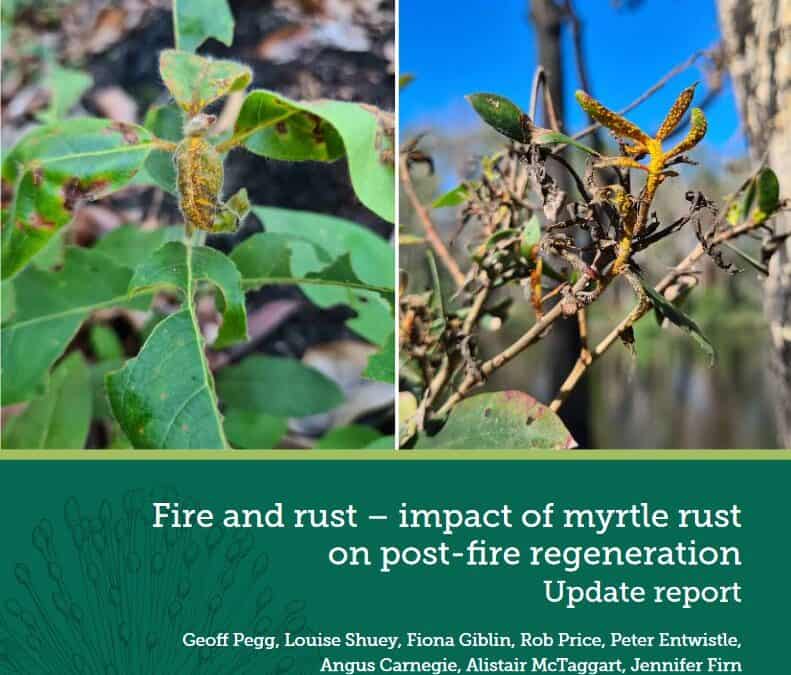Extensive surveys assessing the impact of Myrtle rust (Austropuccinia psidii) were conducted following the 2019/20 wildfires. The two reports are now available for download from our website and make for sobering reading. Myrtle rust symptoms and damage were found in all survey sites in fire-affected areas of south-east Queensland and NSW south to the Central coast region. New host species have been identified including Leptospermum speciosum (Showy tea tree), Eucalyptus pyrocarpa (Large-fruited blackbutt) and Eucalyptus amplifolia subsp. amplifolia (Cabbage gum). Significant impacts were identified on the endangered Rhodamnia rubescens (Scrub turpentine) and Uromyrtus australis (Peach myrtle). Myrtle rust symptoms have been observed for the first time on Eucalyptus pilularis (Blackbutt) and Syncarpia hillii (Satinay) on World Heritage K’gari (Fraser Island). Regeneration of Melaleuca quinquenervia (Broad-leaved paperbark), particularly in New South Wales, is of concern with the loss of established trees, and only 15 to 35% of seedlings showing evidence of resistance. Melaleuca nodosa (Prickly-leaved paperbark) is highly susceptible to Myrtle rust with only small numbers of trees showing resistance/tolerance to the disease. Longer-term monitoring of all sites is required to understand the impacts of Myrtle rust on Myrtaceae regenerating after wildfire. The ANPC would like to thank the Threatened Species Recovery Hub for funding this project.
Recent Posts
- Australasian Myrtle Rust Conference 2025 – Program and free virtual attendance links released
- New option for treatment of Myrtle Rust
- Save the Date! APCC15 to be held in August 2026 in Port Douglas QLD
- Myrtle Rust Management for Practitioners – next session 24 April 2025 2-3PM (AEST)
- Australasian Myrtle Rust Conference 2025 | 16-17 June 2025 | Auckland, New Zealand
Archives
- June 2025
- May 2025
- April 2025
- March 2025
- January 2025
- December 2024
- October 2024
- September 2024
- August 2024
- July 2024
- May 2024
- March 2024
- February 2024
- January 2024
- December 2023
- November 2023
- October 2023
- September 2023
- August 2023
- July 2023
- June 2023
- May 2023
- April 2023
- March 2023
- February 2023
- January 2023
- November 2022
- October 2022
- September 2022
- August 2022
- July 2022
- May 2022
- February 2022
- December 2021
- November 2021
- October 2021
- September 2021
- August 2021
- July 2021
- May 2021
- April 2021
- March 2021
- February 2021
- December 2020
- November 2020
- October 2020
- September 2020
- August 2020
- July 2020
- June 2020
- May 2020
- April 2020
- March 2020
- February 2020
- January 2020
- November 2019
- October 2019
- September 2019
- August 2019
- June 2019
- May 2018

